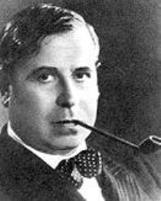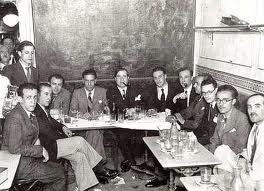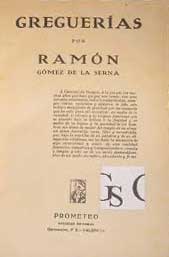Life of Ramon Gomez de la Serna
Ramón Gómez de la Serna Puig was a prolific Spanish writer, part of the Spanish literary Generation of '14, and inventor of the literary genre greguería. He wrote essays, biographies, poems, novels, and even plays, although these weren't too successful. He wrote around 100 books, which have been translated into many languages, and had his own literary gathering in the Café Pombo in Madrid. He was a famous author in Spain, and very well considered in Paris and Buenos Aires, where he spent many years.
Ramon Gomez de la Serna - Life

Ramon Gomez de la Serna was born in Madrid in 1888. His family moved to Palencia when he was still a boy. They spent three years there, and then the family moved back to Madrid, where he studies in a school in Madrid. His uncle was a writer and de la Serna, influenced by him. starts to write.
In 1903 de la Serna finishes his baccalaureate and his father gifts him a trip to Paris, which he takes alone. Back in Spain he starts to study Law in Madrid, though he didn't like it much. His uncle publishes a book at the age of 17 and de la Serna makes an effort to emulate him. In 1905 his father funds his first book, "Entrando en fuego". In 1908 he goes back to study Law in the University of Oviedo. He finished his degree but never worked in this field, being too absorbed by literature.
In 1908 he publishes his second book, "Morbideces", and his style begins to take form. His mother died during this time, and he starts his literary career in journalism, where he stood out for his originality. He starts to frequent the literary gatherings in Madrid.
De la Serna leaves the family house to live by himself, so he could have more time to write. He starts writing in the magazine "Prometeo" under the pseudonym Tristan. His first contribution was called "El concepto de la nueva literatura", and it would open the door for further contributions, which would last for 4 years. Apart form writing, he also gave conferences at the Ateneo in Madrid. In 1909 he publishes "Beatriz", and later "Desolación", "Ateneo", "El libro mudo" and "Sur del renacimiento escultórico español" in 1911.
At the age of 21 he falls in love with the writer Carmen de Burgos, known as Colombine, who was 20 years older than him. He spends a lot of time with her, and his father, worried about the relationship, finds a job for him in Paris. Carmen visits him in 1909 and decides to stay with him in Paris, from where they traveled across Europe. He continued to contribute in "Prometeo", and nearly at the end of his stay in Paris he invents a new genre: his greguerías.

He spends some time in Madrid but returns to Paris in 1914, where he writes his first novel, "El doctor inverosimil". The war breaks out and de la Serna returns to Madrid, where he gets the idea to start his own literary gathering and establishes it in the Café Pombo, where it would happen once a week from 1914 to 1936. He wrote a book about them in 1918, called "El Pombo", and years later wrote a second volume called "La Sagrada Cripta del Pombo".
De la Serna's father dies in 1922 and he leaves family home, which now housed only de la Serna and his 4 siblings. His job in the city council end abruptly when the dictatorship of Primo de Rivera begins. With the money he inherited from his father, de la Serna builds a house for himself in Lisbon and travels there frequently. By this time, his income came from the articles he wrote for "El Liberal" and from his books, but his economic situation was never too buoyant and he has to sell his house in Portugal. He starts to write for the newspapers "El Sol" and "La Voz". He was 35, and already popular in the literary and journalistic circles.
He begins to contribute in "Revista de Occidente" (which he would do until 1936) and starts to write biographies. He moves to Naples to escape from the repression of the dictatorship and returns two years later, when his books are beginning to be translated. He travels around Spain giving conferences, and continued writing his greguerías (short statements, usually not longer than one sentence, in which the author expresses a philosophical, pragmatic, or humorous idea in a witty and original way). Valéry Larbaud introduces them in France under the name échantillons.
He starts writing for "La Nación" and in 1929 he tried to write a play, "Los medios seres", which was a failure. He spends some years traveling to Paris and even rents a studio there. In Madrid he signs a contract with Unión Radio to have a microphone installed in his house so he could contribute to the radio everyday. In 1930 he travels to Buenos Aires and at he falls in love with Luisa Sofovich, who returns to Madrid with him in 1923. He goes back to Buenos Aires for the publication of one of his books there, and at his return to Spain he finds a very difficult political situation. He helps fund the "Alianza de Intelectuales Antifascistas para la Defensa de la Cultura", and, scared his literary gathering would end up divided in different political views, decided to end it, together with his radio collaborations.

With the start of the Spanish Civil War, de la Serna and his wife leave Spain for Argentina. It takes him a while, but de la Serna slowly begins to take part in the cultural life of Buenos Aires and continues to write his greguerías and biographies. In 1944 he starts to write articles for the newspaper "Arriba". At the end of the '40s he starts to write his autobiography, "Automoribundia", which is published in 1948. De la Serna is already 60 years old nd is feeling nostalgic about Madrid, which shows in his novel "Las tres gracias", set in the Spanish capital.
In 1949 he returns to Madrid, invited by the president of the Ateneo. He spent his time there giving conferences, seeing friend, taking part in literary gatherings... Luisita and him return to Buenos Aires about a month later. From 1953 to 1960 de la Serna published 12 books and several thousand journalistic articles. The change of direction in the newspaper "Arriba" doesn't work for de la Serna, and he starts sending his greguerías to the Spanish newspaper "ABC". In Argentina he writes scripts for TV and acquires some fame.
His last years in Buenos Aires are spent mostly inside, and his illness worsens. In 1962 he receives the literary price Juan March, and in 1963 he dies in Buenos Aires, at the age of 75.

